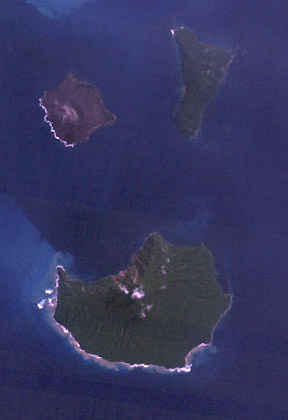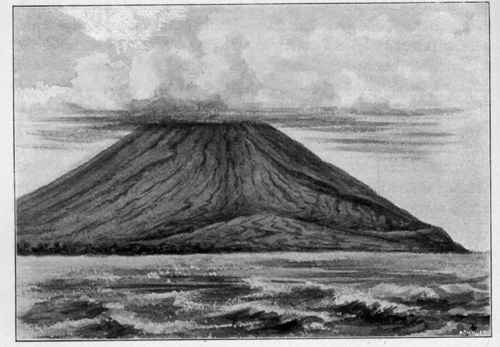|
Krakatoaaka Krakatau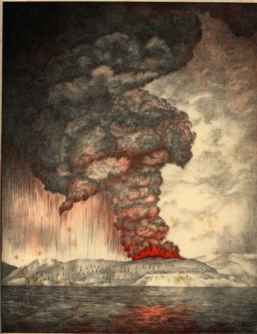 In recent years, the world has become a little bit jaded about disasters, between Katrina, tsunamis and spectacular terrorist attacks. But Krakatoa was one for the ages.
In recent years, the world has become a little bit jaded about disasters, between Katrina, tsunamis and spectacular terrorist attacks. But Krakatoa was one for the ages.Between the biggest volcanic eruption in recorded history and the resulting orgy of tsunamis, the explosion of Krakatoa in 1883 vaporized an entire island, killed almost 40,000 people and literally changed the maps. The scary thing is that the 1883 eruption wasn't the biggest geological event to take place on that site. The volcano had begun to smolder in May, after a strong earthquake struck the region. Passing ships reported seeing a column of black smoke more than six miles high. Clouds of ash and pumice belched from the island, located in a strait between Sumatra and Java in Indonesia, and the sound of explosions could be heard as far as 100 miles away. At first, everyone said "oh, cool, explosions" in the same way one might respond to a particularly violent thunderstorm. Then, in August, the island began blowing up in earnest. Louder and bigger and with more debris, until finally it exploded on August 27 with a force of 30,000 megatons—approximately one million times more powerful than the blast that leveled Hiroshima.
Lava flows from the eruption were so hot that they traveled more than 20 miles over the ocean water without cooling into volcanic rock, searing a path onto the mainland and burning hundreds of people to death. The lava that did cool solidified in the sea lanes and prevented rescue ships from reaching the afflicted. Overall, the volcano spewed out five cubic miles of rock, ash and lava. Searing ash clouds killed hundreds more around the region, and vast amounts of ash were propelled into the stratosphere, where they were caught by the winds and spread to every corner of the globe.
The consequences of the ash cloud globally were nearly as dramatic as the effect of the tsunamis locally, although much less deadly. The world's average temperature dropped by several degrees as the cloud obstructed the heat of the sun.
The first big detonation of Krakatoa occurred 75 million years ago when evil space dictator Xenu detonated an atomic bomb at the site (and others around the earth). At least, that's what you believe if you're an insane Scientologist whose brain has deteriorated after shelling out thousands of dollars to the keepers of L. Ron Hubbard's deepest, darkest secrets. Substituting a geological perspective for a theological perspective, we can deduce that there was no Krakatoa 75 million years ago. This is, after all, an incredibly unstable region. The biggest explosion at Krakatoa is believed to have taken place about 60,000 years ago, when the original island blew apart in a volcanic eruption of a magnitude that has never been seen in the modern world. The global effects of that explosion are lost to us, as there was no written language at the time. However, there were records of world history by the sixth century, around the time of yet another major eruption at Krakatoa. Recorded in only sketchy detail by local scripture-writers, the evidence for the explosion is more forensic than literate. The blast took place at the start of what we fondly refer to those years as the Dark Ages, and therein lies a story. From Europe to Japan, and all points between, several historians and volcanologists have noted that historical accounts in the vicinity of 535 A.D. describe a climactic event in which the sun was blotted out and the summer never came. The most famous of these was by Roman chronicler John of Ephesus:
There was a sign from the Sun, the likes of which had never been seen or reported before. The Sun became dark, and its darkness lasted for about 18 months. Each day, it shown for about four hours and still this light was only a feeble shadow. Everyone declared that the Sun would never recover its full light again.The size of the explosion in 535 is not entirely clear from the geological record, but it appears to have been prodigious. Analysis from the Los Alamos National Laboratory suggests that the eruption could have created a 500-foot shroud of ash around the entire planet. There is a substantial amount of evidence to suggest that Krakatoa's 6th century explosion may have precipitated a worldwide famine (plants, you see, do not grow well without sun) and even an outbreak of bubonic plague in the Roman Empire (the Romans had import vast amounts of grain to offset the poor growing conditions, and the grain shipments are implicated as the source of the plague). With all this chaos and destruction, the outstanding question on which to close this account is painfully obvious—what next? Christian fundamentalists are rather fond of Krakatoa as an example of God's wrath and a blueprint for what lies ahead, though they don't necessarily predict that "the big one" will pop up at the same location. At the site of the old Krakatoa island, a new volcano has slowly emerged from the sea, like Godzilla returning for a romp through Tokyo. Anak Krakatau (literally "Son of Krakatau") is much smaller than the original edition, but it's growing steadily. The most optimistic scenario sees another earth-changing explosion within a few hundred years. Those with a more Apocalyptic bent need not despair, however. Volcanologists assure us that—sooner or later—we will be witness to a supervolcano explosion that stands a reasonably good chance of obliterating all life on earth. Whether at Krakatoa itself, or in the middle of Yellowstone Park (a real possibility), "the big one" will probably cover an entire continent in ash, rock and magma, pollute the atmosphere for years straight and create a decades-long worldwide winter, with fairly good odds of destroying human civilization as we know it. Mother Nature is a cruel mistress. Enjoy the good times while you can.
|
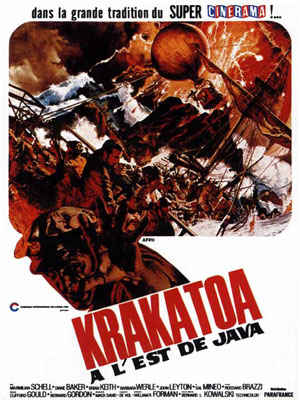 Suddenly, it wasn't so cool anymore. About two thirds of the island crumbled and sank into an submarine crater. The lava flowed like ocean waves, and the ocean waves smashed like wrecking balls into the surrounding coastlines. The blasts and related seismic activity created 120 foot waves of black water that rammed into Java and Sumatra and devastated the towns and villages lining the crowded commercial sea lane. Smaller islands in the strait were completed submerged. More than 36,000 people were killed. Thousands of corpses washed up on shore in the weeks that followed.
Suddenly, it wasn't so cool anymore. About two thirds of the island crumbled and sank into an submarine crater. The lava flowed like ocean waves, and the ocean waves smashed like wrecking balls into the surrounding coastlines. The blasts and related seismic activity created 120 foot waves of black water that rammed into Java and Sumatra and devastated the towns and villages lining the crowded commercial sea lane. Smaller islands in the strait were completed submerged. More than 36,000 people were killed. Thousands of corpses washed up on shore in the weeks that followed. 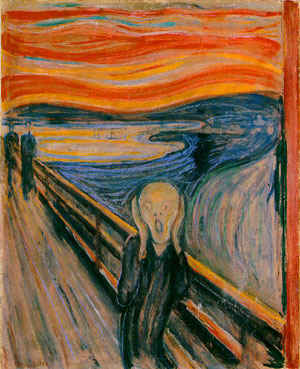 The sun and the moon appeared to be surrounded by ruddy halos, and the skies at dawn and dusk were bloody. Artists around the world tried to capture the colors, most memorably Edvard Munch in his infamous painting,
The sun and the moon appeared to be surrounded by ruddy halos, and the skies at dawn and dusk were bloody. Artists around the world tried to capture the colors, most memorably Edvard Munch in his infamous painting, 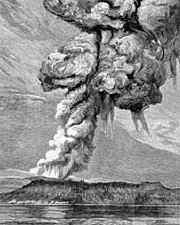 The scariest thing about the eruption of Krakatoa in 1883 is that it could happen again, only much, much worse. In fact, there's evidence to support the idea that it happened earlier—and was much, much worse.
The scariest thing about the eruption of Krakatoa in 1883 is that it could happen again, only much, much worse. In fact, there's evidence to support the idea that it happened earlier—and was much, much worse. 